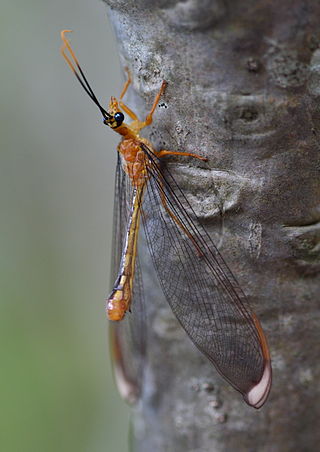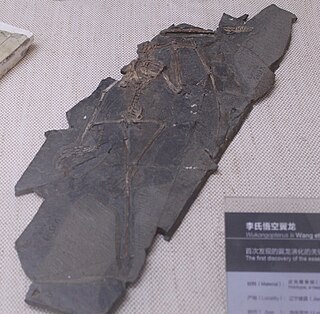
Derodontidae is a family of beetles, in its own superfamily, Derodontoidea, sometimes known as the tooth-necked fungus beetles. Beetles of this family are small, between 2 and 6 mm in length, typically with spiny margins on their pronotum that give them their name, though the genus Laricobius lacks these spines. Unusual among beetles, they have two ocelli on the top of their heads.

Pedopenna is a genus of small, feathered, maniraptoran dinosaur from the Daohugou Beds in China. It is possibly older than Archaeopteryx, though the age of the Daohugou Beds where it was found is debated. A majority of studies suggest that beds probably date from between the late Middle Jurassic and early Late Jurassic Period.

Scansoriopteryx is a genus of maniraptoran dinosaur. Described from only a single juvenile fossil specimen found in Liaoning, China, Scansoriopteryx is a sparrow-sized animal that shows adaptations in the foot indicating an arboreal (tree-dwelling) lifestyle. It possessed an unusual, elongated third finger which may have supported a membranous wing, much like the related Yi qi. The type specimen of Scansoriopteryx also contains the fossilized impression of feathers.

Castorocauda is an extinct, semi-aquatic, superficially otter-like genus of docodont mammaliaforms with one species, C. lutrasimilis. It is part of the Yanliao Biota, found in the Daohugou Beds of Inner Mongolia, China dating to the Middle to Late Jurassic. It was part of an explosive Middle Jurassic radiation of Mammaliaformes moving into diverse habitats and niches. Its discovery in 2006, along with the discovery of other unusual mammaliaforms, disproves the previous hypothesis of Mammaliaformes remaining evolutionarily stagnant until the extinction of the non-avian dinosaurs.

Eomeropidae is a family of aberrant, flattened scorpionflies represented today by only a single living species, Notiothauma reedi, known from the Nothofagus forests in southern Chile, while all other recognized genera in the family are known only as fossils, with the earliest definitive fossil known from Liassic-aged strata, and the youngest from Paleogene-aged strata.

The Tettigarctidae, known as the hairy cicadas, are a small relict family of primitive cicadas. Along with more than 20 extinct genera, Tettigarctidae contains a single extant genus, Tettigarcta, with two extant species, one from southern Australia and one from the island of Tasmania. Numerous fossil species have been described from the Late Triassic onwards. Tettigarcta are the closest living relatives of the true cicadas.

Osmylidae are a small family of winged insects of the net-winged insect order Neuroptera. The osmylids, also called lance lacewings, stream lacewings or giant lacewings, are found all over the world except North and Central America. There are around 225 extant species.

Pseudotribos is an extinct genus of mammaliaform that lived in Northern China during the Middle Jurassic some 165 million years ago, possibly more closely related to monotremes than to theria, although other studies indicate that these shuotheres are closer to therians than to monotremes. The only known specimen was found in the Daohugou Bed in Inner Mongolia.

Nymphidae, sometimes called split-footed lacewings, are a family of winged insects of the order Neuroptera. There are 35 extant species native to Australia and New Guinea.
Jeholotriton is a genus of primitive salamander from the Daohugou Beds near Daohugou village of Inner Mongolia, China.

Liaoxitriton is an extinct genus of prehistoric cryptobranchoid salamanders from the Early Cretaceous of China. It contains one species, L. zhongjiani, from the Aptian aged Yixian Formation. A second species, L. daohugouensis from the Middle/Late Jurassic Daohugou Beds, was moved to the genus Neimengtriton in 2021 after a number of studies noted morphological differences between the two genera.

Wukongopterus is a genus of basal pterosaur, found in Liaoning, China, from the Daohugou Beds, of the Middle or Late Jurassic. It was unusual for having both an elongate neck and a long tail.
The Haifanggou Formation, also known as the Jiulongshan Formation, is a fossil-bearing rock deposit located near Daohugou village of Ningcheng County, in Inner Mongolia, northeastern China.
Mesokristensenia is an extinct genus of moth in the family Mesokristenseniidae. It existed in what is now China during the middle Jurassic period. It was named by Huang Diying, André Nel and Joël Minet in 2010, and the type species is Mesokristensenia latipenna.

Palaeontinidae, commonly known as giant cicadas, is an extinct family of cicadomorphs. They existed from the Late Triassic to the Early Cretaceous. The family contains around 30 to 40 genera and around a hundred species.
Mongolbittacus is an extinct genus of hangingfly in the family Bittacidae and containing a single species Mongolbittacus daohugoensis. The species is known only from the Middle Jurassic Jiulongshan Formation, part of the Daohugou Beds, near the village of Daohugou in Ningcheng County, northeastern China.
Formosibittacus is an extinct genus of hangingfly in the family Bittacidae and containing a single species Formosibittacus macularis. The species is known only from the Middle Jurassic Jiulongshan Formation, part of the Daohugou Beds, near the village of Daohugou in Ningcheng County, northeastern China.
Jurahylobittacus is an extinct genus of hangingfly in the family Bittacidae and containing a single species Jurahylobittacus astictus. The species is known only from the Middle Jurassic Jiulongshan Formation, part of the Daohugou Beds, near the village of Daohugou in Ningcheng County, northeastern China.
Daohugoupterus is a genus of pterosaur from the Middle to Late Jurassic Daohugou Beds of the Tiaojishan Formation in Inner Mongolia, China.

Archisargidae is an extinct family of brachyceran flies known from the Jurassic and Cretaceous periods. It is part of the extinct superfamily Archisargoidea. Most members of the family are known from the Callovian-Oxfordian Daohugou biota of Inner Mongolia, China, and the equivalently aged Karabastau Formation of Kazakhstan. The family has been found to be paraphyletic with respect to Eremochaetidae in a cladistic analysis.













